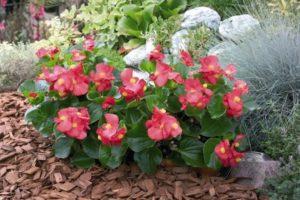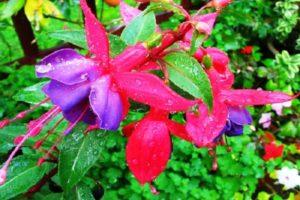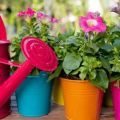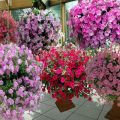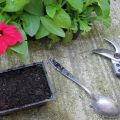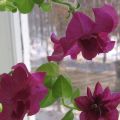Description and characteristics of ampel petunia varieties, cultivation and care
Florists have been cultivating petunia for over 100 years. The ampelous appearance of the plant attracts with its versatility. Varieties of ampelous petunias can be grown in flower beds, flowerpots, pots, on balconies. Thanks to hanging lashes with lush flowers, the plant becomes a decoration of the garden, room.
Features of ampelous petunia
Unlike other types of decorative culture, the ampelous one is distinguished by the fact that:
- The shoots hang down instead of growing up.
- The length of the stems varies from 30 centimeters to one meter.
- Leaves are light green, slightly pubescent.
- The petals of various colors are not completely cut, they look like bells.
- Bred small-flowered and large-flowered variants.
You can choose from a variety of varieties of ampel petunia species with simple flowers and double. But the cultivation of an ornamental plant requires careful attention to the conditions of cultivation and care of the crop.
The best varieties of petunia ampelous
The breeders gave the flower growers a choice of the variety of ampelous petunias that can grow in pots. All of them are distinguished by the duration of flowering, exactingness to growing conditions.
Easy Wave
The variety from American breeders can be grown in pots and in a flower bed. The compact bush blooms successfully in 7 liter flowerpots. In this case, the flowers form a lush cloud, behind which the foliage is not visible. At first, the stems of the plant reach 25-30 centimeters, gradually expanding to 1 meter. On a flower bed, petunia forms a continuous bright carpet.
Of the varieties, varieties can be distinguished those in which the petals are painted in a yellow color scheme. An interesting petunia with dark red flowers and a black center, crimson or purple petals, in the middle of which is a white stripe. The length of the buds of the hybrid reaches 7 centimeters. Large flowers have a delicate violet scent.
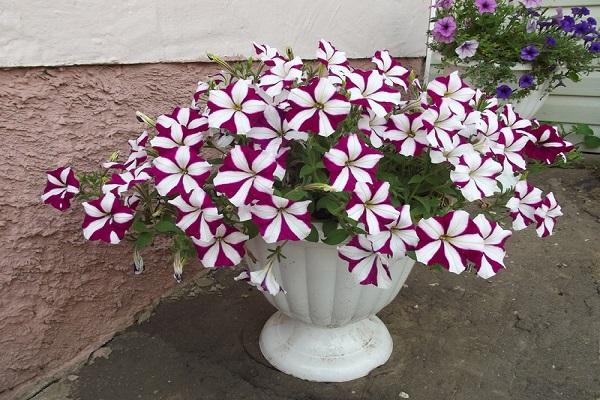
Surfinia
The peculiarity of the hybrid is:
- early flowering;
- the power of the stems;
- variety of colors;
- the formation of a luxurious cap of small flowers.
In the petunia variety, they note the tenderness of the petals, their sophistication. They are used in decorating balconies, gazebos, houses.
Avalanche
The variety is distinguished by large flowers with a diameter of 10 centimeters, which look like a gramophone. They attract petals with a yellow center and border with their uniqueness.During the entire growing season, the plant is covered with buds. It resembles a bright avalanche of flowers. The branching of the stems allows the use of petunia for ground cover beds. The flower decorates the facades of houses.
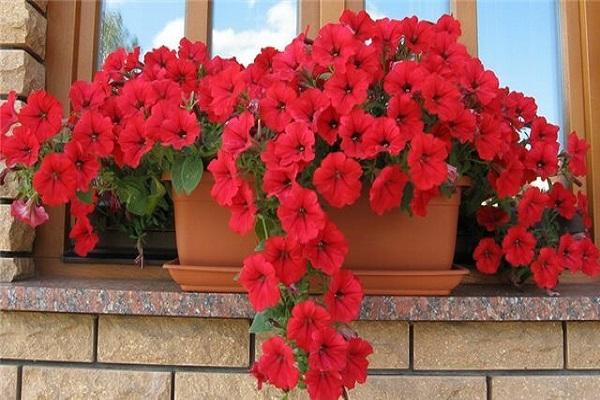
Velveteen
Velvety foliage and large flowers are characteristic of the hybrid. Ampel petunia is solid, from white to dark purple, and pink. There are also petals decorated with spots, stripes, dots. The Velvet variety belongs to excellent honey plants.
Opera Supreme
Classic ampelous petunia is undemanding to light, nutrition, unpretentious care. The flexible shoots of the flower quickly grow, spreading and forming lush clumps. At small sizes, the flowers form dense balls of coral, blue-violet, lavender, pink. There are specimens with white petals and a yellow center.
Mashenka
The hybrid has densely branched stems up to 80 centimeters long. Funnel-shaped pink flowers are decorated with a yellow throat. Petunia blooms profusely all summer. Use the flower for growing in a pots. Culture will become a true decoration of the balcony.

Explorer
The hybrid is characterized by a strong growth of shoots. Over time, the lashes reach 80-100 centimeters. The diameter of a flower is on average 5 to 7 centimeters. The glossy waxy surface of the petals can be damaged by rain, but quickly recovers. The series, varied in color, is used as a ground cover and for hanging baskets.
Black velvet
The hybrid appeared by free pollination. The buds are dark purple, almost black, so beautiful that they are chosen for garden design. Moreover, the ampelous look is combined with other flowers in the flowerbed. And in pots, it can be diversified with varieties of contrasting colors.
Svetlana
The ampelous variety stands out with long lashes up to 1 meter and small flowers with a diameter of less than 5 centimeters. The pink petals are decorated with dark veins. Culture prefers light areas of the garden. It blooms more abundantly in warm climates.

The Snow Queen
A hybrid with hanging stems 80 centimeters long looks airy, festive. The flowers of the plant are large, snow-white. Grow petunia in seedlings. It is drought-resistant, light-requiring. After the onset of cold weather, pots with petunia can be brought into the room. It will continue to bloom.
Ekaterina
The ampelous variety is characterized by long hanging shoots of 80 centimeters. The flowers on the stems are small, 5 centimeters long, salmon-colored with dark veins. It is used as a cascading plant in the design of balconies and house facades.
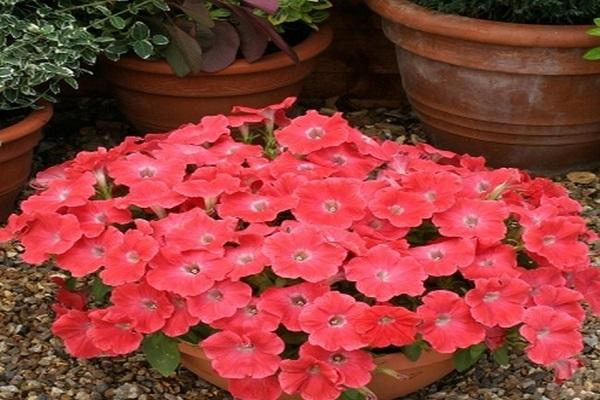
Features of growing and caring for ampel petunia
Usually petunia is grown for open ground in a seedling method. So she manages to take root and bloom all summer.
Growing seedlings from seeds
Already in February and early March, they begin planting flower seeds. The soil is selected from 2 parts of peat, humus and garden soil. To increase the looseness of the soil, coarse sand is needed.
Seeds collected independently are etched in a solution of potassium permanganate. Then they are washed, dried and mixed with sand. Having placed the seed on damp ground, cover it with glass or film. Place containers with petunia in a warm place. Plantings are aired daily, watered as needed.
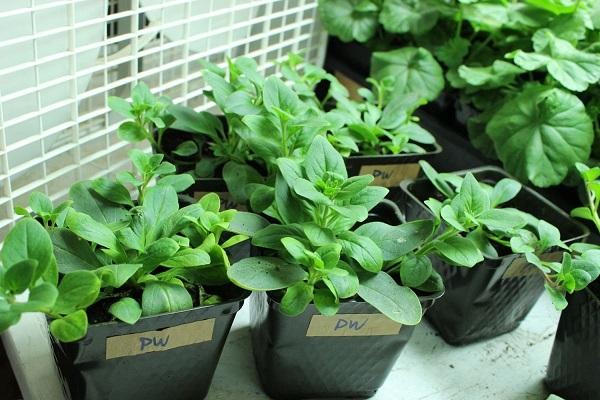
When sprouts appear, boxes with seedlings are placed on lighted windowsills. Seedlings are regularly watered, fed with solutions of organic and mineral fertilizers.
Planting flowers in open ground
It is necessary to transplant petunia when the threat of frost has passed. In the evening, boxes with seedlings are taken out to the prepared area. The holes are placed from each other depending on the size of the flowers of the variety. For small ones, a gap of 10 centimeters is enough, for large ones - 25-30.
The planted bushes are watered, mulched with peat or humus.

Watering and fertilizing
Humidity for petunias needs moderate. Therefore, it is necessary to water the soil as the top layer of the earth dries up. 6-8 waterings are enough per season. It is advisable that water does not fall on the flowers.
Fertilize ampelous flower varieties with depleted soil. Before flowering, it is necessary to apply phosphorus-potassium fertilizers to improve the formation of buds.
Bush formation
By the middle of summer, the shoots of the plant branch strongly, so some of them are removed. Form ampelous petunia by shortening the shoots by 2/3. To exclude exposure of the lower part of the bush, pinch the top of the stems.
It will help to make the bush neat adherence to the rules of care. If there is not enough moisture, microelements, then leaves and buds will begin to fall off. Then they must be cut off, and the plant must be fed.

Seed collection
Usually, wilted petunia flowers are removed, so they do not wait for the formation of seeds. In order not to miss the procedure, you must leave the buds on the lower stems of the plant. After 2 months, the seeds will ripen, which are collected and dried. When propagating by seed, you need to know that the varietal properties of the plant are rarely transmitted.
How a flower reproduces
The seed method of growing petunias is only suitable for planting material purchased in the store. If you collect the seeds yourself, you are unlikely to get the same flowers. The seeds of the flower are very small, they must be planted, laid out on the soil surface. For a month there are boxes with petunias under the tire in a warm place. Then containers with sprouts are placed in bright places at home. It is better to plant plants with 3-4 leaves and buds in the garden.
Cuttings for breeding are cut in February-March. This requires healthy mother plants. On shoots 10 centimeters long, there should be up to 4-6 leaves. Cuttings are planted in boxes with nutrient soil, deepening by a quarter. The leaves are cut off, leaving 2 pieces. Shoots take root on the 5-6th day. A feature of the vegetative propagation method is that the culture begins to bloom on the 25-30th day.
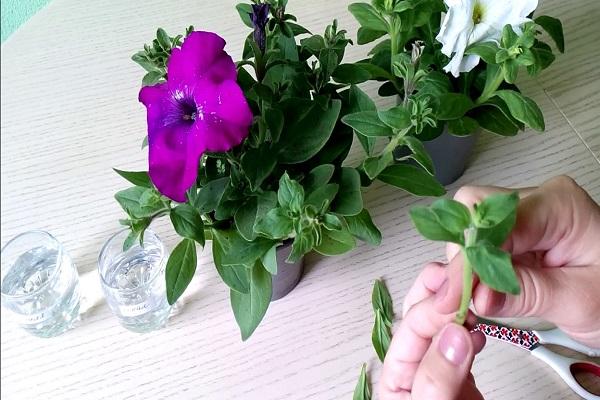
Growing ampelous petunias in pots
Since ampelous petunia is preferred to grow in closed pots, you need to know the rules for such plant cultivation. Many people prefer to immediately plant flowers in pots, so that they can then be taken out into the open air.
Landing rules
For planting in hanging baskets and pots, containers with a volume of 7-10 liters are prepared with holes for excess liquid to drain out. Fill the pots with nutrient soil with good water and air permeability.
You can sow 2-3 seeds in 1 pot. This is usually done in March. Be sure to cover the containers with a film, placing them in a warm place with an air temperature above 23 degrees. Planting must be ventilated and watered.
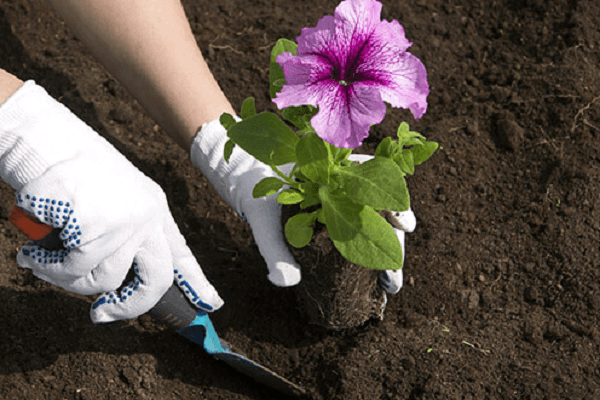
As soon as the seedlings appear, the flowerpots are hung or placed on sunny windowsills. When the sun is not enough, artificial lighting is organized. Petunias need 12-hour daylight hours. After the appearance of 1-2 true leaves, it is necessary to transplant the seedlings into another container, leaving 1-2 plants in the pot. They will grow, filling the entire space of the pots.
Care
It is necessary to care for the potted crop in the same way as in the open field. But here all procedures are carried out carefully, trying not to damage the hanging stems of the ampelous petunia.
Lighting
Petunia is a light-loving plant. It blooms well in open areas. In the shade, the flowers will be smaller and the color will become paler. But from direct sunlight, leaves and buds can dry out. Therefore, they choose such places in the garden where the light will be moderate.
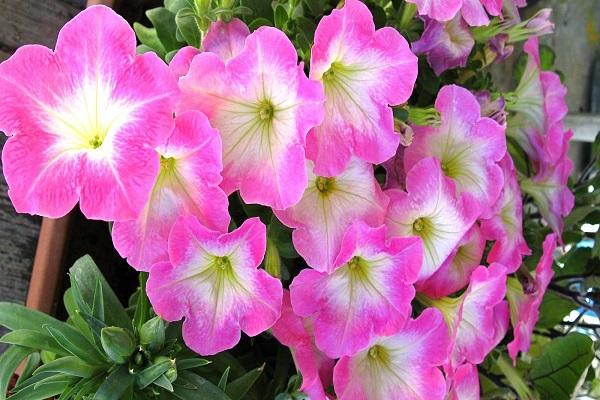
Temperature
The optimum temperature for petunias will be in the range of 20-25 degrees. If the summer is hot, then you need to close the flowers from the scorching rays of the sun or bring them into the pots indoors, on the veranda. But the cold will not allow the plant to bloom profusely.When the cold snap begins in August-September, the pots are brought into the house or veranda.
Watering
Lack of moisture is dangerous for ornamental crops. The flowers begin to fade, and a sticky bloom forms on the leaves from the evaporated essential oils. And this attracts harmful insects. Therefore, it is necessary to exclude the drying out of a clod of earth in a flowerpot. The more developed the plant, the more moisture it needs. Watered in the morning or evening with soft water at room temperature.
Top dressing
Most petunias need nutrition before flowering. They need phosphorus and potassium compounds. Therefore, water the soil in the pots with a solution of superphosphate and potassium salt. For this, mineral complexes are dissolved in a bucket of water. You can replace them with wood ash by taking 50 grams of ash powder per 10 liters of water.

Bud care
The abundance of inflorescences depends on the timely elimination of faded buds. They are cut off along with the pedicels. Then the cap of ampelous varieties of culture will look perfect, without dried inflorescences. And the plant will start up its forces for renewal, rejuvenation.
Disease and pest control
The main causes of fungal infections of the flower are a lot of moisture and heat. This is how pathogens infect plants in flower beds and hanging baskets. The leaves begin to become stained, dry up, and the buds fall off without opening. It is necessary to water less crops in rainy seasons. Diseases can be prevented by spraying Bordeaux liquid 2-3 times during the growing season.
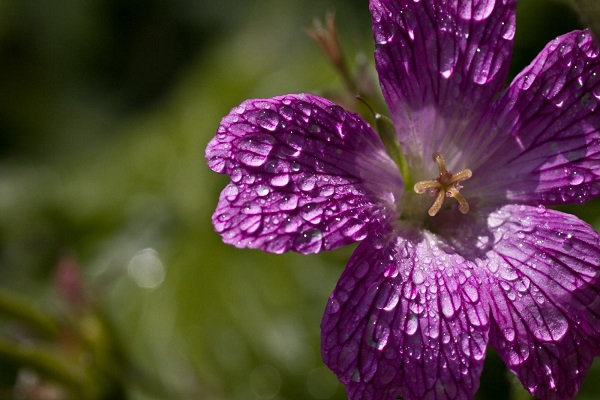
Aphids on the leaves are fought by treating the bushes with insecticidal agents. Infusion of tobacco will also help. The spider mite loves to hit the flower. He will begin to suck the juices from the plant, and it will dry out. It is necessary to insist a handful of onion peels for 12 hours in hot water in an amount of 0.5 liters. Then dilute with infusion with water and pour over petunia.
Compliance with the rules of flower agricultural technology is one of the most effective methods of preventing diseases and pest attacks.
